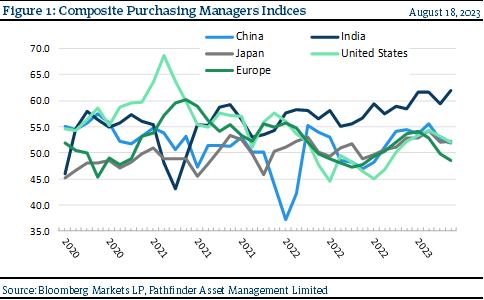The Management View continued...
Last week, we wrote about Purchasing Managers’ Indices (PMIs). PMI indices are calculated by taking a monthly survey of business intentions from managers. The output is a score where over 50 indicates expected business expansion and under 50 indicates business contraction. We include Figure 1 below which presents combined manufacturing and services data for major economies. In the last issue of the Outlook, we noted that, depending on the economy, services or manufacturing can be significant drivers (e.g. the US has far more services business, while China has far more manufacturing). We watch the data regularly as we are trying, much like everyone else, to see if we can gauge the forward health of the global economy and the potential for recession. This topic caused a lot of debate during our desk calls with the investment team this week.
- As you can see in Figure 1, other than Europe, aggregate PMIs are above 50 for the major economies. Forward management expectations remain constructive. The US, Japan and China have remained in the low 50s since mid-2022, while India and Europe are the positive and negative outliers respectively.

- We also debated the definition of a recession. Usually, it is defined as two quarters of negative GDP growth, but that has happened, or been very close, this year for a few important countries (US, Germany, Japan, UK) with no recession declared. Most investors watch the National Bureau of Economic Research (here) for a formal declaration of recession but the process of identifying a recession is a little opaque and usually happens long after the recession has actually occurred (essentially useless from an investment perspective).
- We also debated the shape of the yield curve, which has been inverted. This is usually an indicator of a coming recession; however, the current inversion could be potentially different and more like the 1960s, when an inversion was not followed by a recession. We are watching this closely as well.
- We also reviewed savings rates and credit card deliquencies to form an opinion on consumer health. With respect to that, this quote from the Walmart Inc. (WMT-U), CEO Doug McMillon gives us pause: “I was in Calgary visiting stores a couple of weeks ago, and our Canadian customers are feeling the pinch of higher interest rates faster than in the US, given their shorter-term mortgages.
This means that” we remain cautious. It is difficult to form a clear opinion of the economy going forward and many of our mandates and funds now have significant cash positions: Real Fund (8%), Resource Fund (10%), North American Equity (18%), Partners Fund (28%). We continued to monitor this and other geopolitical issues closely.
National Instrument 31-103 requires registered firms to disclose information that a reasonable investor would expect to know, including any material conflicts with the firm or its representatives. Doug Johnson and/or Pathfinder Asset Management Limited are an insider of companies periodically mentioned in this report. Please visit www.paml.ca for full disclosures.
Changes in Leverage. We are increasing the asset ceiling to 2.0 times the market value of equity for Pathfinder International Fund and Pathfinder Real Fund to be consistent with Pathfinder Partners’ Fund and Pathfinder Resource Fund
*All returns are time weighted and net of investment management fees. Returns from the Pathfinder Partners’ Fund and Partners’ Real Return Plus Fund are presented based on the masters series of each fund. The Pathfinder Core: Equity Portfolio and The Pathfinder Core: High Income Portfolio are live accounts. These are actual accounts owned by the Pathfinder Chairman (Equity) and client (High Income) which contain no legacy positions, cash flows or other Pathfinder investment mandates or products. Monthly inception dates for each fund and portfolio are as follows: Pathfinder Core: Equity Portfolio (January 2011), Pathfinder Core: High Income Portfolio (October 2012) Partners’ Fund (April 2011), Partners’ Real Return Plus Fund (April, 2013), and Partners’ Core Plus Fund (November 2014).
Pathfinder Asset Management Limited (PAML) and its affiliates may collectively beneficially own in excess of 10% of one or more classes of the issued and outstanding equity securities mentioned in this newsletter. This publication is intended only to convey information. It is not to be construed as an investment guide or as an offer or solicitation of an offer to buy or sell any of the securities mentioned in it. The author has taken all usual and reasonable precautions to determine that the information contained in this publication has been obtained from sources believed to be reliable and that the procedures used to summarize and analyze such information are based on approved practices and principles in the investment industry. However, the market forces underlying investment value are subject to sudden and dramatic changes and data availability varies from one moment to the next. Consequently, neither the author nor PAML can make any warranty as to the accuracy or completeness of information, analysis or views contained in this publication or their usefulness or suitability in any particular circumstance. You should not undertake any investment or portfolio assessment or other transaction on the basis of this publication, but should first consult your portfolio manager, who can assess all relevant particulars of any proposed investment or transaction. PAML and the author accept no liability of any kind whatsoever or any damages or losses incurred by you as a result of reliance upon or use of this publication.